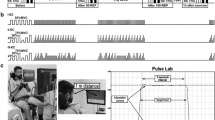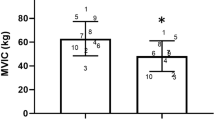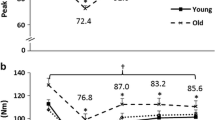Abstract
Healthy aging is associated with a marked decline in motor performance. The functional consequences of applying varying novel or unexpected motor stimuli during intermittent isometric prolonged (fatiguing) motor tasks for lower limb neuromuscular fatigability and steadiness, perception of effort, and blood markers of stress in healthy aged men compared with young men have not been investigated. The participants in this study were 15 young men (aged 22 ± 4 years) and 10 older men (aged 67 ± 6 years). They performed 100 intermittent isometric knee extensions under three experimental conditions involving intermittent isometric contraction tasks according to constant, predictable, and unpredictable torque target sequences. The variability in maximal voluntary contraction averaged 50%, and was 25, 50, and 75% for the three strategies. All included a 5-s contraction and 20-s rest. The main variables were measured before exercise, after 100 repetitions, and 1 h after exercise. In all experimental trials, the decreases in the maximal voluntary contraction and central activation ratio, and the increases in effort sensation and muscle temperature, were smaller in older men than in younger men. The coefficient of variation during the motor performance did not differ between age groups. However, in all three strategies, the dopamine concentration was significantly higher in older than in younger men. The prolactin concentration did not differ significantly between age groups or conditions, although its decrease during loading correlated negatively with the central activation ratio.




Similar content being viewed by others
References
Allman BL, Rice CL (2002) Neuromuscular fatigue and aging: central and peripheral factors. Muscle Nerve 25:785–796
Bernecke V, Pukenas K, Imbrasiene D, Mickeviciene D, Baranauskiene N, Eimantas N, Brazaitis M (2015) Test-retest cross-reliability of tests to assess neuromuscular function as a multidimensional concept. J Strength Cond Res 29:1972–1984
Bernecke V, Pukenas K, Daniuseviciute L, Baranauskiene N, Paulauskas H, Eimantas N, Brazaitis M (2017) Sex-specific reliability and multidimensional stability of responses to tests assessing neuromuscular function. Homo 68:452–464
Bouche P, Cattelin F, Saint-Jean O, Léger JM, Queslati S, Guez D, Moulonguet A, Brault Y, Aquino JP, Simunek P (1993) Clinical and electrophysiological study of the peripheral nervous system in the elderly. J Neurol 240:263–268
Brazaitis M, Skurvydas A, Vadopalas K, Daniusevičiūtė L, Senikienė Z (2011) The effect of heating and cooling on time course of voluntary and electrically induced muscle force variation. Medicina (Kaunas) 47:39–45
Brazaitis M, Skurvydas A, Pukėnas K, Daniuseviciūtė L, Mickevicienė D, Solianik R (2012) The effect of temperature on amount and structure of motor variability during 2-minute maximum voluntary contraction. Muscle Nerve 46:799–809
Brazaitis M, Eimantas N, Daniuseviciute L, Vitkauskiene A, Paulauskas H, Skurvydas A (2015) Two strategies for the acute response to cold exposure but one strategy for the response to heat stress. Int J Hyperth 31:325–335
Brazaitis M, Paulauskas H, Eimantas N, Obelieniene D, Baranauskiene N, Skurvydas A (2017) Heat transfer and loss by whole-body hyperthermia during severe lower-body heating are impaired in healthy older men. Exp Gerontol 96:12–18
Bridge MW, Weller AS, Rayson M, Jones DA (2003) Responses to exercise in the heat related to measures of hypothalamic serotonergic and dopaminergic function. Eur J Appl Physiol 89:451–459
Brümmer V, Schneider S, Struder HK, Askew CD (2011) Primary motor cortex activity is elevated with incremental exercise intensity. Neuroscience 181:150–162
Callahan DM, Umberger BR, Kent JA (2016) Mechanisms of in vivo muscle fatigue in humans: investigating age-related fatigue resistance with a computational model. J Physiol 594:3407–3421
Cham R, Perera S, Studenski SA, Bohnen NI (2011) Age-related striatal dopaminergic denervation and severity of a slip perturbation. J Gerontol A Biol Sci Med Sci 66:980–985
Christie A, Snook EM, Kent-Braun JA (2011) Systematic review and meta-analysis of skeletal muscle fatigue in old age. Med Sci Sports Exerc 43:568–577
Cupido CM, Hicks AL, Martin J (1992) Neuromuscular fatigue during repetitive stimulation in elderly and young adults. Eur J Appl Physiol Occup Physiol 65:567–572
Davies CT, White MJ (1983) Effects of dynamic exercise on muscle function in elderly men, aged 70 years. Gerontology 29:26–31
Davis MJ, Bailey SP (1997) Possible mechanisms of central nervous system fatigue during exercise. Med Sci Sports Exerc 29:45–57
Degens H, Korhonen MT (2012) Factors contributing to the variability in muscle ageing. Maturitas 73:197–201
Dorfman LJ, Bosley TM (1979) Age-related changes in peripheral and central nerve conduction in man. Neurology 29:38–44
Enoka RM (2008) Motor unit recruitment threshold. J Appl Physiol (1985) 105:1676
Enoka RM, Duchateau J (2008) Muscle fatigue: what, why and how it influences muscle function. J Physiol 586:11–23
Enoka RM, Christou EA, Hunter SK, Kornatz KW, Semmler JG, Taylor AM, Tracy BL (2003) Mechanisms that contribute to differences in motor performance between young and old adults. J Electromyogr Kinesiol 13:1–12
Gorianovas G, Skurvydas A, Streckis V, Brazaitis M, Kamandulis S, McHugh MP (2013) Repeated bout effect was more expressed in young adult males than in elderly males and boys. Biomed Res Int 2013:1–10
Harrison SJ, Stergiou N (2015) Complex adaptive behavior and dexterous action. Nonlinear Dyn Psychol Life Sci 19:345–394
He SB, Tang WG, Tang WJ, Kao XL, Zhang CG, Wong XT (2012) Exercise intervention may prevent depression. Int J Sports Med 33:525–530
Hornby TG, Moore JL, Lovell L, Roth EJ (2016) Influence of skill and exercise training parameters on locomotor recovery during stroke rehabilitation. Curr Opin Neurol 29:677–683
Horvitz JC (2000) Mesolimbocortical and nigrostriatal dopamine responses to salient non-reward events. Neuroscience 96:651–656
Hunter SK, Thompson MW, Ruell PA, Harmer AR, Thom JM, Gwinn TH, Adams RD (1999) Human skeletal sarcoplasmic reticulum Ca2+ uptake and muscle function with aging and strength training. J Appl Physiol (1985) 86:1858–1865
Hunter SK, Todd G, Butler JE, Gandevia SC, Taylor JL (2008) Recovery from supraspinal fatigue is slowed in old adults after fatiguing maximal isometric contractions. J Appl Physiol (1985) 105:1199–1209
Hunter SK, Pereira HM, Keenan KG (2016) The aging neuromuscular system and motor performance. J Appl Physiol 121:982–995
Ingram DK (2000) Age-related decline in physical activity: generalization to nonhumans. Med Sci Sports Exerc 32:1623–1629
Justice JN, Mani D, Pierpoint LA, Enoka MR (2014) Fatigability of the dorsiflexors and associations among multiple domains of motor function in young and old adults. Exp Gerontol 55:92–101
Kent-Braun JA (1999) Central and peripheral contributions to muscle fatigue in humans during sustained maximal effort. Eur J Appl Physiol Occup Physiol 80:57–63
Kent-Braun JA, Ng AV, Doyle JW, Towse TF (2002) Human skeletal muscle responses vary with age and gender during fatigue due to incremental isometric exercise. J Appl Physiol (1985) 93:1813–1823
Kent-Braun JA, Callahan DM, Fay JL, Foulis SA, Buonaccorsi JP (2014) Muscle weakness, fatigue, and torque variability: effects of age and mobility status. Muscle Nerve 49:209–217
Kyguoliene L, Skurvydas A, Eimantas N, Baranauskienė N, Mickeviciene D, Urboniene D, Cernych M, Brazaitis M (2017) Effect of constant, predictable, and unpredictable motor tasks on motor performance and blood markers of stress. Exp Brain Res 235:1323–1336
Lanza IR, Befroy DE, Kent-Braun JA (2005) Age-related changes in ATP-producing pathways in human skeletal muscle in vivo. J Appl Physiol (1985) 99:1736–1744
Lanza IR, Larsen RG, Kent-Braun JA (2007) Effects of old age on human skeletal muscle energetics during fatiguing contractions with and without blood flow. J Physiol 583:1093–1105
Lindstrom B, Lexell J, Gerdle B, Downham D (1997) Skeletal muscle fatigue and endurance in young and old men and women. J Gerontol A Biol Sci Med Sci 52:B59–B66
Ljungberg T, Apicella P, Schultz W (1992) Responses of monkey dopamine neurons during learning of behavioral reactions. J Neurophysiol 67:145–163
Low D, Cable T, Purvis A (2005) Exercise thermoregulation and hyperprolactinaemia. Ergonomics 48:1547–1557
McNeil CJ, Rice CL (2007) Fatigability is increased with age during velocity-dependent contractions of the dorsiflexors. J Gerontol A Biol Sci Med Sci 62:624–629
Meeusen R, Watson P, Hasegawa H, Roelands B, Piacentini MF (2006) Central fatigue: the serotonin hypothesis and beyond. Sports Med 36:881–909
Müller H, Sternad D (2009) Motor learning: changes in the structure of variability in a redundant task. Adv Exp Med Biol 629:439–456
Nokin J, Vekemans M, L'Hermite M, Robyn C (1972) Circadian periodicity of serum prolactin concentration in man. BMJ 3(5826):561–562
Noteboom JT, Barnholt KR, Enoka RM (2001) Activation of the arousal response and impairment of performance increase with anxiety and stressor intensity. J Appl Physiol (1985) 91:2093–2101
Osu R, Burdet E, Franklin DW, Milner TE, Kawato M (2003) Different mechanisms involved in adaptation to stable and unstable dynamics. J Neurophysiol 90:3255–3269
Pranskunas A, Pranskuniene Z, Milieskaite E, Daniuseviciute L, Kudreviciene A, Vitkauskiene A, Skurvydas A, Brazaitis M (2015) Effects of whole body heat stress on sublingual microcirculation in healthy humans. Eur J Appl Physiol 115:157–165
Ranganathan R, Newell KM (2013) Changing up the routine: intervention-induced variability in motor learning. Exerc Sport Sci Rev 41:64–70
Río-Rodríguez D, Iglesias-Soler E, Fernández Del Olmo M (2016) Set configuration in resistance exercise: muscle fatigue and cardiovascular effects. PLoS One 11:e0151163
Roelands B, Goekint M, Heyman E, Piacentini MF, Watson P, Hasegawa H, Buyse L, Pauwels F, De Schutter G, Meeusen R (2008) Acute norepinephrine reuptake inhibition decreases performance in normal and high ambient temperature. J Appl Physiol (1985) 105:206–212
Rojas Vega S, Hollmann W, Strüder HK (2012) Influences of exercise and training on the circulating concentration of prolactin in humans. J Neuroendocrinol 24:395–402
Rolland Y, Czerwinski S, Abellan Van Kan G, Morley JE, Cesari M, Onder G, Woo J, Baumgartner R, Pillard F, Boirie Y, Chumlea WM, Vellas B (2008) Sarcopenia: its assessment, etiology, pathogenesis, consequences and future perspectives. J Nutr Health Aging 12:433–450
Rubinstein S, Kamen G (2005) Decreases in motor unit firing rate during sustained maximal-effort contractions in young and older adults. J Electromyogr Kinesiol 15:536–543
Scaglioni G, Narici MV, Maffiuletti NA, Pensini M, Martin A (2003) Effect of ageing on the electrical and mechanical properties of human soleus motor units activated by the H reflex and M wave. J Physiol 548:649–661
Schultz W (2016) Dopamine reward prediction-error signalling: a two-component response. Nat Rev Neurosci 17:183–195
Sokoloff P, Le Foll B (2017) The dopamine D3 receptor, a quarter century later. Eur J Neurosci 45:2–19
Stergiou N, Harbourne R, Cavanaugh J (2006) Optimal movement variability: a new theoretical perspective for neurologic physical therapy. J Neurol Phys Ther 30:120–129
Vanden Noven ML, Pereira HM, Yoon T, Stevens AA, Nielson AK, Hunter SK (2014) Motor variability during sustained contractions increases with cognitive demand in older adults. Front Aging Neurosci 6:1–14
Venckunas T, Skurvydas A, Brazaitis M, Kamandulis S, Snieckus A, Moran CN (2012) Human alpha-actinin-3 genotype association with exercise-induced muscle damage and the repeated-bout effect. Appl Physiol Nutr Metab 37:1038–1046
Vijg J, Campisi J (2008) Puzzles, promises and a cure for ageing. Nature 454:1065–1071
Wang FC, de Pasqua V, Delwaide PJ (1999) Age-related changes in fastest and slowest conducting axons of thenar motor units. Muscle Nerve 22:1022–1029
Acknowledgements
The authors thank Mrs. Danute Juciene for collecting the blood samples and gathering the volunteers to participate in this research. Funding for this work was provided by the Research Council of Lithuania (Grant no. MIP-017/2014).
Author information
Authors and Affiliations
Contributions
The authors AS and MB contributed to the design of the work. The authors LK, NE, NB, MC, and HP performed the experiments. The authors LK, AS, MB, RS, LD, HP, and MC contributed to the analysis and interpretation of data for the work. The authors LK, AS, and MB drafted the work for important intellectual content. All authors finally approved the version to be submitted. The author MB contributed to the revision of this work. All the authors agreed to be accountable for all aspects of the work in ensuring that questions related to the accuracy or integrity of any part of the work are appropriately investigated and resolved.
Corresponding author
Ethics declarations
Conflict of interest
The authors declare that they have no conflict of interest.
Ethical approval
All procedures performed in studies involving human participants were in accordance with the ethical standards of the institutional and/or national research committee and with the 1964 Declaration of Helsinki and its later amendments or comparable ethical standards.
Informed consent
Written informed consent was obtained from all participants included in the study.
Rights and permissions
About this article
Cite this article
Kyguoliene, L., Skurvydas, A., Eimantas, N. et al. Three different motor task strategies to assess neuromuscular adjustments during fatiguing muscle contractions in young and older men. Exp Brain Res 236, 2085–2096 (2018). https://doi.org/10.1007/s00221-018-5285-4
Received:
Accepted:
Published:
Issue Date:
DOI: https://doi.org/10.1007/s00221-018-5285-4




